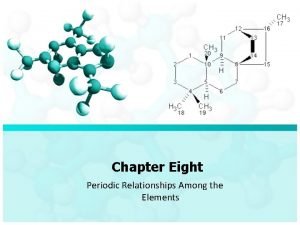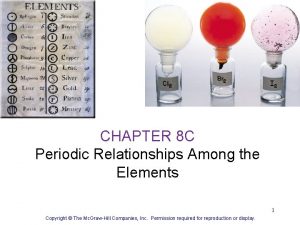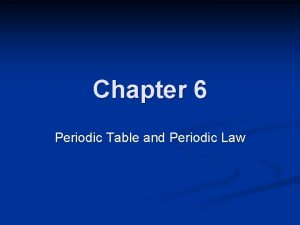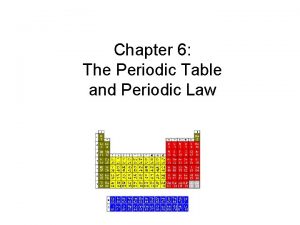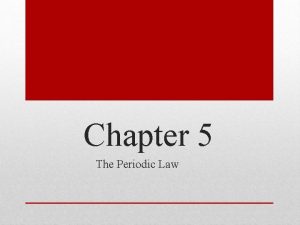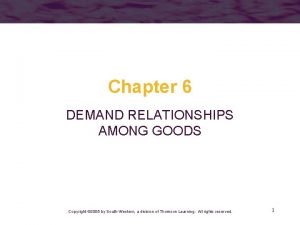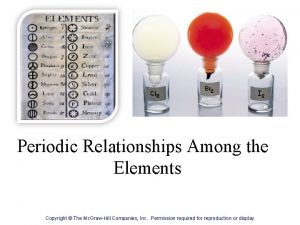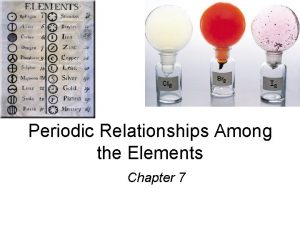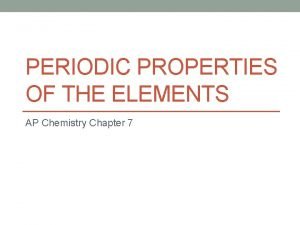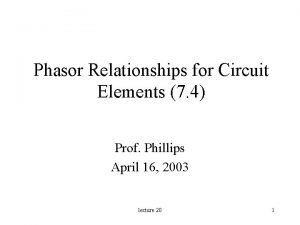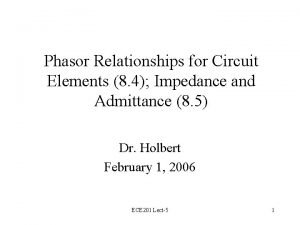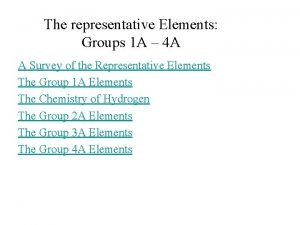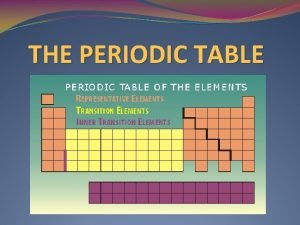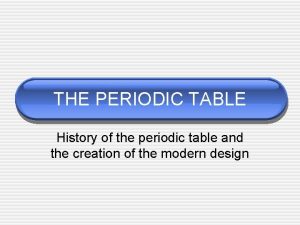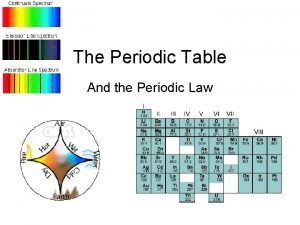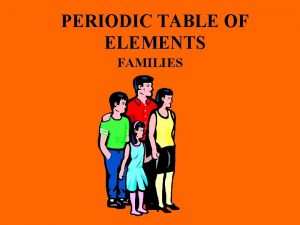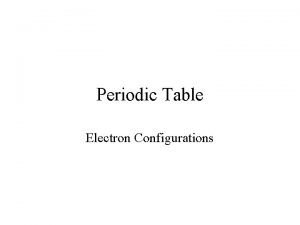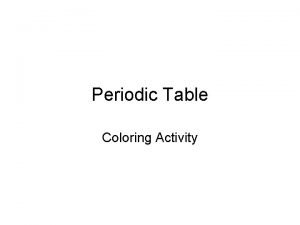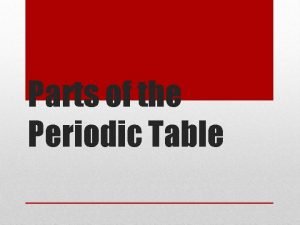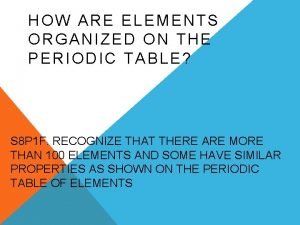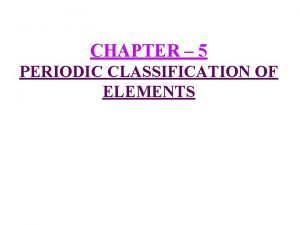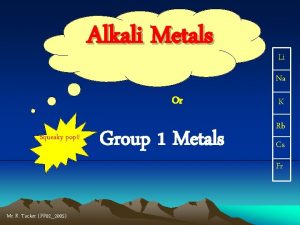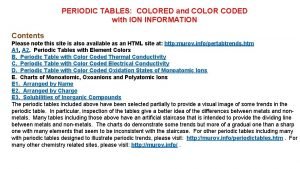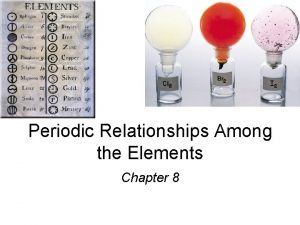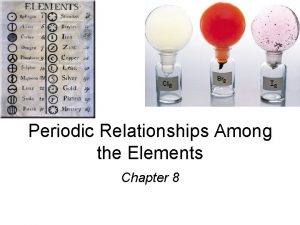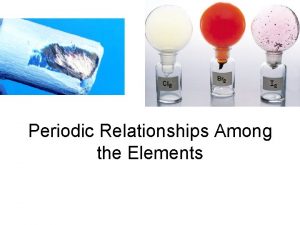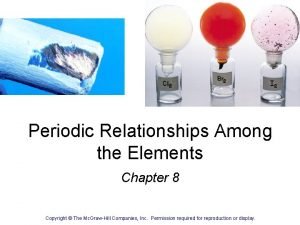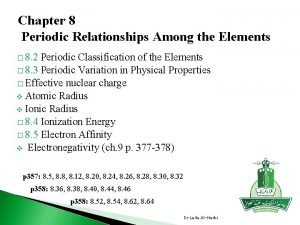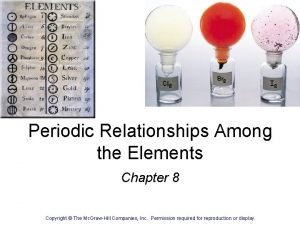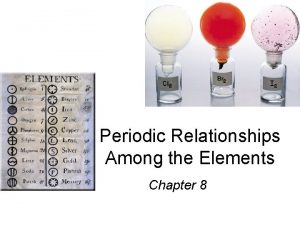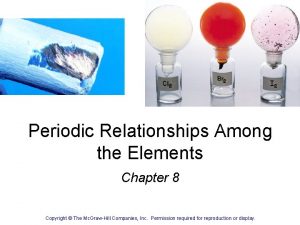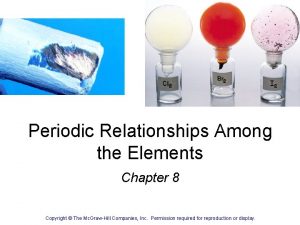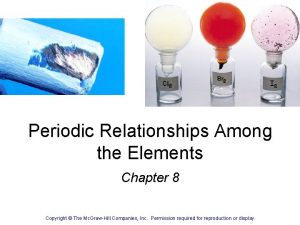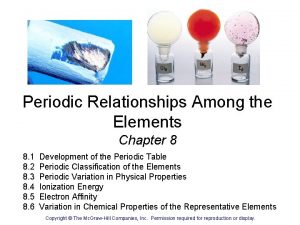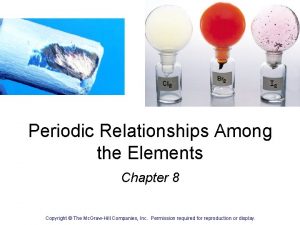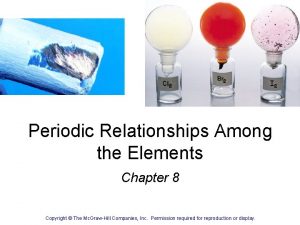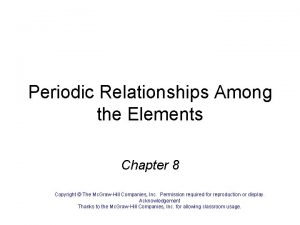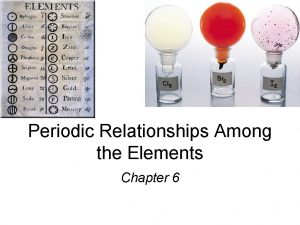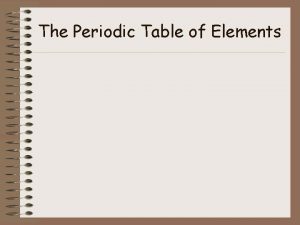Chapter Eight Periodic Relationships Among the Elements Chapter




































- Slides: 36

Chapter Eight Periodic Relationships Among the Elements

Chapter Eight/ Periodic Relationships Among the Elements Development of the Periodic Table • Many attempt has been made to arrange the element. • Russian Chemist Dmitri Mendeleev arrange the element based on the regular, periodic recurrence of properties. • Mendeleev’s classification system was a great improvement for two reasons. First, it grouped the elements together more accurately, according to their properties. Equally important, it made possible the prediction of the properties of several elements that had not yet been discovered. Dmitri Mendeleev 1834 -1907

Chapter Eight/ Periodic Relationships Among the Elements Development of the Periodic Table • Mendeleev’s classification was based on the atomic weight, however, this resulted in some inconsistency. • Later on after the discovery of atomic number by Henry Moseley the element were arranged by their atomic number.

Chapter Eight/ Periodic Relationships Among the Elements Periodic Classification of the Elements Group Period

4 f 5 f 5 ns 2 np 6 ns 2 np 5 ns 2 np 4 ns 2 np 3 ns 2 np 1 d 10 d 5 Within a Period number of electrons increase Within a group (n) increase d 1 ns 2 ns 1 Periodic Classification of the Elements ns 2 np 2 Chapter Eight/ Periodic Relationships Among the Elements

Chapter Eight/ Periodic Relationships Among the Elements Periodic Classification of the Elements Example: The element that has the valance electron configuration 3 s 2 3 p 3 is: a)Carbon b) Nitrogen c) Phosphorus d)Neon

Chapter Eight/ Periodic Relationships Among the Elements Periodic Classification of the Elements Example 2: An atom of a certain element has 15 electrons. Without consulting a periodic table, answer the following questions: (a) What is the ground-state electron configuration of this element? 1 s 2 2 p 6 3 s 2 3 p 3 (b) How should be element be classified? Period 3, group 5 A The element is representative element. (c) Is the element diamagnetic or paramagnetic 3 s 2 3 p 3

Chapter Eight/ Periodic Relationships Among the Elements Development of the periodic table Example: Which of the following sets of elements is expected to have similar chemical properties? a) Sulfur and phosphorous b) Sulfur and oxygen c) Sulfur and argon

Chapter Eight/ Periodic Relationships Among the Elements Periodic Classification of the Elements Example Titanium (Ti) element is found in the periodic table in s-block (b) P-block (c) d-block (d) f-block Example Characteristics of noble gases include: a. filled s and p subshells. b. monatomic gases. c. generally unreactive chemical. d. all of the above.

Chapter Eight/ Periodic Relationships Among the Elements Periodic Classification of the Elements ns Outermost orbitals OR Outermost electrons OR Valence electrons ns ns np ns (n-1)d 10

Chapter Eight/ Periodic Relationships Among the Elements Electron Configration of Cation and Anio Ion derived from representative element In the formation of a cation from the atom of a representative element, one or more electrons are removed from the highest occupied n shell so that Cation has a noble-gas outer electron configuration. The electron configurations of some atoms and their corresponding cations are as follows: Na: [Ne] 3 s 1 Na+ [Ne] Ca: [Ar] 4 s 2 Ca 2+ [Ar] Al: [Ne] 3 s 23 p 1 Al 3+ [Ne]

Chapter Eight/ Periodic Relationships Among the Elements Electron Configration of Cation and Anio Ion derived from representative element In the formation of an anion, one or more electrons are added to the highest Partially filled n shell so that anion has a noble-gas outer electron configuration. Consider the following examples: H: 1 s 1 H- 1 s 2 or [He] F: 1 s 22 p 5 F- 1 s 22 p 6 or [Ne] O: 1 s 22 p 4 O 2 - 1 s 22 p 6 or [Ne] N: 1 s 22 p 3 N 3 - 1 s 22 p 6 or [Ne]

Chapter Eight/ Periodic Relationships Among the Elements Electron Configration of Cation and Anio Ion derived from representative element Isoelectronic: Species with the same number of electrons. Example : H- : [He] , F- : [Ne], N-3: [Ne] , Na+ : [Ne] , Al+3 : [Ne], O-2 : [Ne] 11 Na 13 Al (11 e) → Na+ (10 e) (13 e) →Al 3+ (10 e) 7 N (7 e) → N 3 - (10 e) 9 F (9 e) → F- (10 e) 8 O (8 e) → O 2 - (10 e) 10 Ne (10 e) THUS: All are isolelctronic to Ne

Chapter Eight/ Periodic Relationships Among the Elements Electron Configration of Cation and Anio Ion derived from representative element Example: Which of the following species is isoelectronic with Cl- 18 e (a) F(b) O 2 - (c) K+ (d) Na+ 10 e 18 e 10 e

Chapter Eight/ Periodic Relationships Among the Elements Electron Configration of Cation and Anio Ion derived from transition element When a cation is formed from an atom of a transition metal, electrons are always removed first from the ns orbital and then from the (n – 1)d orbitals. Example: Mn: [Ar]4 s 23 d 5 Mn 2+: [Ar] 3 d 5 Fe: [Ar]4 s 23 d 6 Fe 2+: [Ar]3 d 6 Fe 3+: [Ar]3 d 5

Chapter Eight/ Periodic Relationships Among the Elements Variation in physical prosperities Effective nuclear charge(Zeff): the nuclear charge felt by an electron when both the actual nuclear charge ( Z ) and the repulsive effects (shielding) of the other electrons are taken into account. Where σ (sigma) is called the shielding constant.

Chapter Eight/ Periodic Relationships Among the Elements Variation in physical prosperities Effective nuclear charge

Chapter Eight/ Periodic Relationships Among the Elements Variation in physical prosperities Effective nuclear charge Valence electron Core electron The core electrons shield valence electrons MUCH MORE than valence electrons shield one another.

Chapter Eight/ Periodic Relationships Among the Elements Variation in physical prosperities Effective nuclear charge increasing Zeff

Chapter Eight/ Periodic Relationships Among the Elements Variation in physical prosperities Atomic Radius: is one-half the distance between the two nuclei in two adjacent metal atoms or in a diatomic molecule.

Chapter Eight/ Periodic Relationships Among the Elements Variation in physical prosperities Atomic Radius Increasing atomic radius Decreasing atomic radius

Chapter Eight/ Periodic Relationships Among the Elements Variation in physical prosperities Atomic Radius Example Referring to a periodic table, arrange the following atoms in order of increasing atomic radius: P, Si, N? N <P <Si

Chapter Eight/ Periodic Relationships Among the Elements Variation in physical prosperities Atomic Radius Example Which choice below correctly lists the elements in order of increasing atomic radius? a-Na < Mg < K < Rb b-Mg < Na < K < Rb c-Rb< K < Na < Mg d-Rb< K < Mg < Na

Chapter Eight/ Periodic Relationships Among the Elements Variation in physical prosperities Ionic Radius: is the radius of a cation or an anion. If the atom forms an anion, its size (or radius) increases, because the nuclear charge remains the same but the repulsion resulting from the additional electron(s) enlarges the domain of the electron cloud However, If the atom forms an cation, its size (or radius) decreases, because the nuclear charge remains the same but electron-electron repulsion decreases so the electron cloud shrinks. – Anion is always larger than atom from which its formed. – Cation is always smaller than atom from which its formed. Cations< Anions

Chapter Eight/ Periodic Relationships Among the Elements Variation in physical prosperities Ionic Radius • The ionic radius increases from the top to the bottom of the group • For ions in different groups: they should be isoelectronic • Isolelectronic ions: o cations < anions: example Na+ < Fo Isolelectronic cations: example Al 3+, Mg 2+, Na+ Al 3+ < Mg 2+ < Na+ o Isoelectronic anoins: example O 2 -, FF- < O 2 -

Chapter Eight/ Periodic Relationships Among the Elements Variation in physical prosperities Ionic Radius Example For each of the following pairs, indicate which one is larger: a. N 3 - or FN 3 - b- Mg 2+ or Ca 2+ c-Fe 2+ or Fe 3+ Fe 2+

Chapter Eight/ Periodic Relationships Among the Elements Variation in physical prosperities Ionic Radius • Isoelectronic cations: Ø Example: 10 Al+3, 10 Mg+2, 10 Na+ Ø Arrangement of increasing ionic radius: 10 Al+3< 10 Mg+2 < 10 Na+ • Isoelectronic anions Ø Example: 10 F-, 10 O-2, 10 N-3 Ø Arrangement of increasing ionic radius: 10 F- < 10 O-2 < 10 N-3

Chapter Eight/ Periodic Relationships Among the Elements Variation in physical prosperities Ionic Radius Example Order the following according to the increase in atomic/ionic radius. N 3– Li+ C O 2– a- C < Li+ < O 2– < N 3– b- N 3– < O 2– < C < Li+ c- Li+ < C < N 3– < O 2– d- Li+ < C < N 3– < O 2– e- Li+ < C < O 2– < N 3– Always Cation < neutral < anion For cation the larger the charge the smaller the radius For anion the smaller the charge the smaller the radius

Chapter Eight/ Periodic Relationships Among the Elements Ionization Energy : is the minimum energy (in k. J/mol) required to remove an electron from a gaseous atom in its ground state. The higher the ionization energy, the more difficult to remove the electron from the atom. For a many-electron atom, the amount of energy required to remove the first electron from the atom in its ground state, is called the first ionization energy(I 1). To remove the second electron is called he second ionization energy (I 2) and to remove third electron is called the third ionization energy ( I 3). I 1 < I 2 < I 3 ……. .

Chapter Eight/ Periodic Relationships Among the Elements Ionization Energy First Ionization energy decrease First Ionization energy Increase

Chapter Eight/ Periodic Relationships Among the Elements Ionization Energy Exception • 2 A>3 A • 5 A>6 A Example Which atom should have a smaller first ionization energy: oxygen or sulphur?

Chapter Eight/ Periodic Relationships Among the Elements Ionization Energy Example Arrange the following in order of increasing first ionization energy: F, K, P, Ca, and Ne. K < Ca < P < F < Ne

Chapter Eight/ Periodic Relationships Among the Elements Electron Affinity : is the negative change of the energy that occurs when an electron is accepted by an atom in the gaseous state to form an anion. The higher electron affinity, the greater affinity to accept the electron. The Electron Affinity for non-metal is higher than metal , EA for metalloid fall between metals and nonmetals. The Electron Affinity decreases from top to the bottom of the group. The Electron Affinity increase from left to right in period. Exception 2 A<1 A 5 A<4 A Noble gases have the lowest electron affinities Halogens have the largest electron affinities

Chapter Eight/ Periodic Relationships Among the Elements Electron Affinity Example Which choice correctly lists the elements in order of decreasing electron affinity? a-O, Cl, B, C b-O, Cl, C, B c-Cl, O, C, B d-Cl, O, B, C

Chapter Eight/ Periodic Relationships Among the Elements Electron Affinity Example Specify which of the following elements you would expect to have the greatest electron affinity and which have the least: He, K, Co, S, Cl He < K < Co < S < Cl

 Periodic relationships among the elements
Periodic relationships among the elements Periodic relationships among the elements
Periodic relationships among the elements Periodic relationships
Periodic relationships Plane shape
Plane shape A short section of corrugated roadway that warns of hazards
A short section of corrugated roadway that warns of hazards Chapter 6 the periodic table
Chapter 6 the periodic table 6 the periodic table
6 the periodic table Chapter 5 periodic law
Chapter 5 periodic law A flowchart that depicts the relationships among the input
A flowchart that depicts the relationships among the input Demand relationships among goods
Demand relationships among goods Periodic relationships
Periodic relationships Periodic relationships
Periodic relationships The 8 elements of culture
The 8 elements of culture Common elements of music
Common elements of music Perioidic trends
Perioidic trends Alien periodic table periodic trends answers
Alien periodic table periodic trends answers Ap chemistry chapter 7 periodic properties of the elements
Ap chemistry chapter 7 periodic properties of the elements Phasor relationships for circuit elements
Phasor relationships for circuit elements Eli the ice man
Eli the ice man Where are the representative elements on the periodic table
Where are the representative elements on the periodic table Periodic table outline
Periodic table outline Where is the most reactive elements on the periodic table
Where is the most reactive elements on the periodic table Periodic table of elements summary
Periodic table of elements summary Youtube.com
Youtube.com Atomic size periodic trend
Atomic size periodic trend Metals on periodic table of elements
Metals on periodic table of elements Properties of alkali metals
Properties of alkali metals Horizontal rows on the periodic table
Horizontal rows on the periodic table Carbon electron configuration
Carbon electron configuration Coloring and labeling the periodic table
Coloring and labeling the periodic table Element cheat sheet
Element cheat sheet Representative elements periodic table
Representative elements periodic table How are elements organized in the periodic table?
How are elements organized in the periodic table? Periodic classification of elements
Periodic classification of elements Alkali metals colour
Alkali metals colour Color coded periodic table of elements
Color coded periodic table of elements Periodic table of literary elements
Periodic table of literary elements
